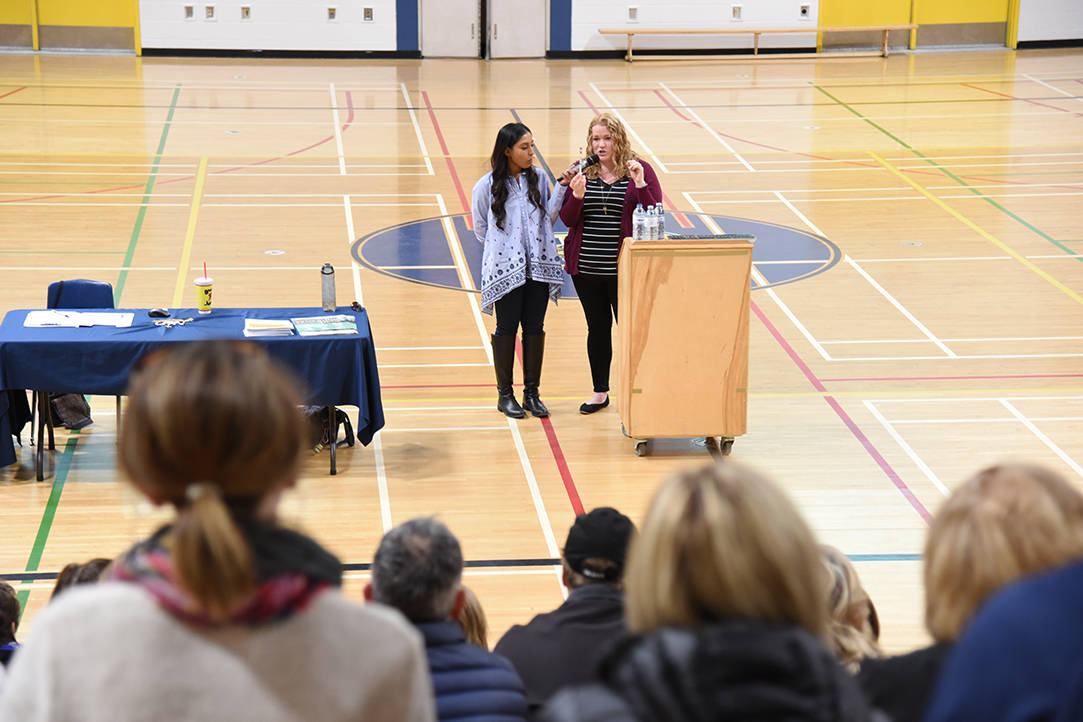École Secondaire Notre Dame High School in partnership with Turning Point and the RCMP hosted a public information session on the opioid crisis in Central Alberta on March 26th.
“We’re talking about it preventatively—it’s not at a crisis state at all [in the high schools],” said Sarah Fleck, managing registered nurse at Turning Point.
“As parents we need you to help us, because when we get involved it’s not to solve the problem anymore, it’s to prevent it,” said Const. Sean Morris from the Red Deer RCMP Youth Unit.
The information session reviewed local statistics, real life stories, facts about the forms and effects of the drugs as well as how to prevent overdoses and administer Naloxone kits.
“For me it was 100 per cent square one getting educated, said Rachelle Scrase, a parent who attended the event with her husband and both her teenage children. “It was very educational to hear how easy it is for youth to access it and how scary a drug it is.”
Morris stressed how essential it is for parents to talk to their kids about opioids and to create boundaries, especially with social media.
“We have to be on top of our children, it’s not snooping, being overprotective or an invasion of privacy,” he said.
According to Morris, parents should know the passwords to all their kids’ social media accounts, know where they are at at all times and not allow adolescents to have cell phones in their rooms at night.
Several parents in attendance said part of what was good about the session was for their kids to hear this from a secondary source.
“We get grief about (their phones always being with us at night) every once in a while, but that’s just the boundaries in our home, so it was nice to hear it reinforced by another person,” said Scrase.
Morris laughed that most parents did not have to grow up in a digital world, twenty years ago and that they need to familiarize themselves as to what is available to their kids.
It’s not about keeping your kids in a bubble and not letting them explore, but making sure that the mistakes they make are not irreversible.
“Parents have an obligation to watch and know what their kids are doing,” Morris said.
He also emphasized that the fentanyl crisis is unique from that of other drugs because it is not contained to a specific demographic.
The opioid crisis does not discriminate.
“EMS are responding to all postal codes in Red Deer—it’s affecting everybody,” Fleck said. “It’s affecting genders, socio economic backgrounds and professions equally.”
Alberta Health, Opioids and Substances of Misuse, Nov 2017 Report, ranked Red Deer as having the second highest fentanyl fatality rates per 100,000 people, in 2017 in Alberta.
In Nov. 2017, there were 482 deaths related to opioid overdoses in Alberta, an increase from 346 in 2016. This represents a 40 per cent increase in fentanyl fatalities in the province.
An average of 1.9 Albertans die every day as a result of an opioid overdose.
Turning Point has had 14 fentayl-related deaths in Red Deer reported to them since Jan. 1st.
People are encouraged not use drugs alone and to always have a Naloxone kit because, once fentanyl is in the user’s system, it is extremely difficult to stop its course due to the nature of absorption.
Naloxone is a drug that can temporarily reverse an opioid overdose.
Fleck explained that Naloxone is a very safe substance that delays the effects of opioids for half an hour to an hour while waiting for emergency services to arrive. But it is not a cure for an overdose, the effects of which will resume after that time.
Turning Point was giving out Naloxone kits at the session, which are also readily available to the community free of charge at pharmacies and walk-in clincs.
Since January, Turning Point has handed out 505 Naloxone kits.
Turning Point has had 94 Naloxone reversals reported to them since January, eight of those resulted in fatalities.
Fleck said that they are hearing repots that people are needing to administer up to nine doses of naloxone, compared to two to three doses previously. This is because of the strength of the drug.
Naloxone does not have adverse effects on someone if they are not overdosing so it is better to administer it unnecessarily than to hesitate.
Sometimes people are hesitant to call 911 when witnessing an overdose, because they are also using and don’t want to get into trouble. Canada’s Good Samaritan law protects those saving a life.
The Good Samaritan Drug Overdose Act, which became law on May 4, 2017 provides legal protection for individuals who seek emergency help during a drug overdose.
The other big surprise for many in attendance was that the drug, which is 100 times as strong as morphine, is not consistently distributed.
Fleck told a story of two boys splitting a pill, one died of a fatal overdose while the other only got a bit high. The inconsistency of the dosage makes it especially dangerous.
One parent expressed shock that the average age kids are exposed to opioids is 12-years-old.
While much of the information was concerning for parents, most said they left feeling they had learned a lot and were glad they had attended. Students said that most of the information presented was familiar to them from school presentations.
There were approximately 80 people in attendance at the information session.



